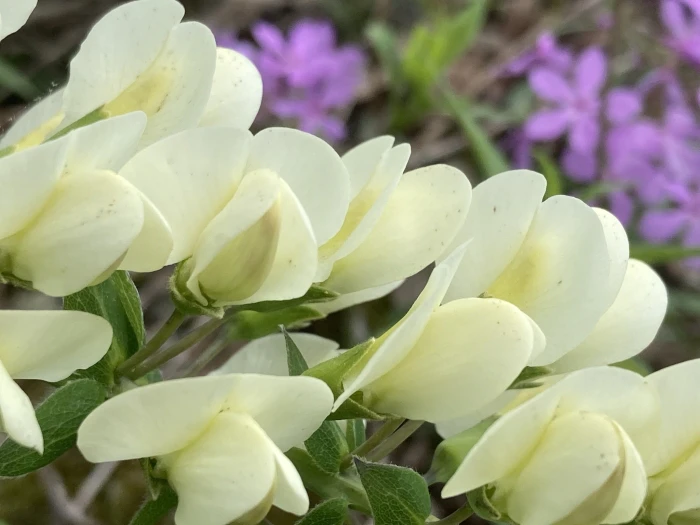Longbract Wild Indigo
(Baptisia bracteata)
Longbract Wild Indigo (Baptisia bracteata)
/
/

Hill Craddock
CC BY 4.0
Image By:
Hill Craddock
Recorded By:
Copyright:
CC BY 4.0
Copyright Notice:
Photo by: Hill Craddock | License Type: CC BY 4.0 | License URL: http://creativecommons.org/licenses/by/4.0/ | Rights Holder: Hill Craddock | Publisher: iNaturalist | Date Created: 2021-04-18T15:14:30-07:00 |




















































Estimated Native Range
Climate Requirements for Buenos Aires, Argentina
| This Plant | Your Site | Plant Suitability for Your Location | ||
|---|---|---|---|---|
| • Precipitation | 17" - 65" | 45" | Aquatic | Aquatic |
| • High Temp. | 72°F - 97°F | 85°F | Your summer temperatures are normal for this plant. | Excellent |
| • Low Temp. | 1°F - 53°F | 44°F | Your winter temperatures are normal for this plant | Excellent |
This plant may not grow well at your location - your precipitation is too high.
Summary
Baptisia bracteata, commonly known as Longbract Wild Indigo, is a deciduous perennial herb native to the tallgrass prairies and open woodlands of the Central and Southeastern USA. It reaches a height and width of 2-3 feet (0.6-0.9 meters), forming clumps of upright stems. The plant is characterized by its long-lasting, showy flower clusters that bloom in spring and early summer, with colors ranging from white to creamy yellow. The racemes are distinctive for their horizontal spread or sprawling nature, which differs from the vertical orientation seen in most Baptisia species. Longbract Wild Indigo is one of the earliest Baptisia to flower, sometimes beginning as early as March in warmer regions.
Longbract Wild Indigo is valued for its early bloom time and attractive flowers, which provide a food source for pollinators like bumblebees. It is also a host plant for caterpillars of certain skippers, including the wild indigo duskywing and hoary edge. This plant is well-suited for naturalistic plantings, prairie restorations, and as a border plant in gardens. It thrives in full sun to part shade and prefers well-drained soils but can tolerate slow-draining soils. While it is drought-tolerant once established, moderate watering will support more vigorous growth. It is generally low-maintenance and resistant to most pests and diseases, but overwatering can lead to root rot. Caution should be taken as the plant is toxic to mammalian herbivores.CC BY-SA 4.0
Longbract Wild Indigo is valued for its early bloom time and attractive flowers, which provide a food source for pollinators like bumblebees. It is also a host plant for caterpillars of certain skippers, including the wild indigo duskywing and hoary edge. This plant is well-suited for naturalistic plantings, prairie restorations, and as a border plant in gardens. It thrives in full sun to part shade and prefers well-drained soils but can tolerate slow-draining soils. While it is drought-tolerant once established, moderate watering will support more vigorous growth. It is generally low-maintenance and resistant to most pests and diseases, but overwatering can lead to root rot. Caution should be taken as the plant is toxic to mammalian herbivores.CC BY-SA 4.0
Plant Description
- Plant Type: Herb
- Height: 2-2.5 feet
- Width: 2-2.5 feet
- Growth Rate: Moderate
- Flower Color: Cream
- Flowering Season: Spring
- Leaf Retention: Deciduous
Growth Requirements
- Sun: Full Sun, Part Shade
- Water: Low, Medium
- Drainage: Medium, Slow
Common Uses
Bee Garden, Bird Garden, Butterfly Garden, Deer Resistant, Drought Tolerant, Hummingbird Garden, Low Maintenance, Rabbit Resistant, Showy Flowers, Street Planting
Natural Habitat
Tallgrass prairies and open woodlands
Other Names
Common Names: Long-Bract Wild Indigo , Long-Bracted Wild Indigo , Cream False Indigo , Plains Wild Indigo
Scientific Names: Baptisia bracteata , Lasinia bracteata
GBIF Accepted Name: Baptisia bracteata Muhl. ex Elliott